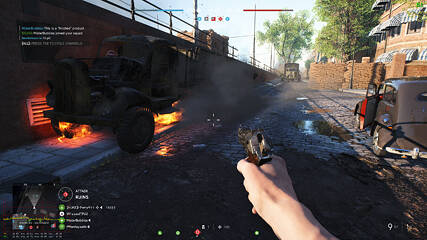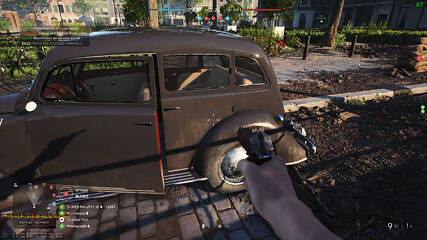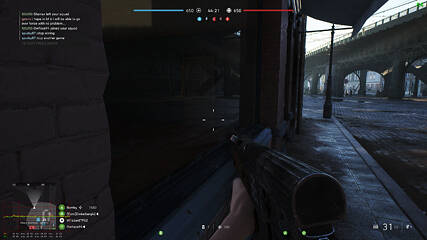 237
237
Battlefield V with GeForce RTX DirectX Raytracing Review
DXR Graphics Settings »Screenshots
For Battlefield, the developer chose to only augment reflections using raytracing. Everything else is rendered just like before. Visually, RTX greatly improves the quality of reflections. This is unlike reflection maps in rasterization and is being rendered in real-time. You see reflections of yourself on non-planar surfaces, such as the body of a car or window panes. Reflections have existed in 3D graphics since DirectX 9.0c, using various tricks; for example, reusing data from screen and painting it on to a reflective surface (screen space reflections). This approach would fail often because it could mirror only parts of the scene that were already visible on-screen somewhere else. Mirrors (planar surfaces) were created using "portals," which are basically drawing the scene from the viewpoint of the mirror a second time and then flipping it. It was impossible to implement portals on non-planar surfaces, and it was especially difficult to create a "hall of mirrors" effect (where a non-planar surface is reflecting your image differently). You could warp a plane viewport over a non-planar surface, but it was inaccurate and very taxing on the machine.The window pane is reflecting the scenery behind the player, which wasn't possible before, without RTX. At the same time, you see part of the scene behind the glass rendered and merged accurately with the reflections.
Here, you see fine examples of reflections from the surface of a car's glossy paint job. This certainly looks more realistic than the red car in the RTX reveal tech-demo. You can see how each surface has a unique way of reflecting the image of your playable character. Warping a planar screen space reflection cannot achieve this. You can even see which weapons the characters are holding!
Here, you notice a scenario where there isn't enough ambient light to reflect you, and the room behind the window pane is too dark.
Note the scene setup: burning truck on the left and a car on the right. On the car's surface, you can see a red reflection, which is the red trim of the open door.
Now, we moved to stand right in front of the car, with the burning truck behind us. Note the faint reflection of the flames slightly above the crosshair. Also, the reflection of the red trim that we saw before is gone now, so it's not just some pre-baked visual texture effect.
Comparison RTX Low vs. RTX Ultra
Below, we've added comparisons between the "Low" (lowest) and "Ultra" (highest) settings of DXR reflections. On the left (below) is "Low," and "Ultra" is to the right. You don't lose all that much in terms of realism, but switching to "Low" significantly reduces your performance loss.
Apr 3rd, 2025 18:40 EDT
change timezone
Latest GPU Drivers
New Forum Posts
- Is RX 9070 VRAM temperature regular value or hotspot? (307)
- [electronics] - STREAM DECK during gaming? (1)
- Homepage list - reviews - no author, no number of comments (1)
- AIO - 120mm cpu cooler? (43)
- Help me pick a UPS (52)
- Someone knowledable on memory voltages want to chime in? (also what is PMIC and should I be worried) (26)
- Microprose: Falcon 5.0 - Well under development- yeay (12)
- New AM5 build [help] (19)
- What's your latest tech purchase? (23460)
- Show us your backside! (8)
Popular Reviews
- DDR5 CUDIMM Explained & Benched - The New Memory Standard
- Sapphire Radeon RX 9070 XT Pulse Review
- SilverStone Lucid 04 Review
- PowerColor Radeon RX 9070 Hellhound Review
- Sapphire Radeon RX 9070 XT Nitro+ Review - Beating NVIDIA
- Pwnage Trinity CF Review
- Palit GeForce RTX 5070 GamingPro OC Review
- ASRock Phantom Gaming B850 Riptide Wi-Fi Review - Amazing Price/Performance
- AMD Ryzen 7 9800X3D Review - The Best Gaming Processor
- Samsung 9100 Pro 2 TB Review - The Best Gen 5 SSD
Controversial News Posts
- MSI Doesn't Plan Radeon RX 9000 Series GPUs, Skips AMD RDNA 4 Generation Entirely (146)
- Microsoft Introduces Copilot for Gaming (124)
- AMD Radeon RX 9070 XT Reportedly Outperforms RTX 5080 Through Undervolting (119)
- NVIDIA Reportedly Prepares GeForce RTX 5060 and RTX 5060 Ti Unveil Tomorrow (115)
- Over 200,000 Sold Radeon RX 9070 and RX 9070 XT GPUs? AMD Says No Number was Given (100)
- NVIDIA GeForce RTX 5050, RTX 5060, and RTX 5060 Ti Specifications Leak (96)
- Retailers Anticipate Increased Radeon RX 9070 Series Prices, After Initial Shipments of "MSRP" Models (90)
- Nintendo Switch 2 Launches June 5 at $449.99 with New Hardware and Games (88)
















